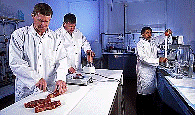United States Department of Agriculture: Agricultural Research Service, Lincoln, Nebraska

Roman L. Hruska U.S. Meat Animal Research Center: Reports
Date of this Version
1988
Document Type
Article
Abstract
Why an interest in twinning in cattle?
. More than one-half of the feed units used by the national beef herd are needed to meet maintenance requirements of the reproducing female population.
. The beef cow is capable of producing about .7 of her body weight per year in progeny market weight.
. The sow is capable of producing more than 8 times her body weight per year in progeny market weight.
. The meat type hen is capable of producing more than 70 times her body weight per year in progeny market weight.
. The channel catfish female is capable of producing more than 1,000 times her body weight per year in progeny market weight.
Research objectives of this project are: (1) Determine the effectiveness of selection for multiple births in cattle and estimate genetic correlations between twinning rate and other bioeconomic traits; (2) develop selection criteria and procedures for multiple births in cattle; (3) accumulate data that will contribute to an economic assessment of multiple births in cattle for varying production resource situations; (4) establish nutritional and other managerial requirements for herds of cattle that have a high twinning frequency; (5)determine the relative importance of multiple ovulation and embryo survival in contributing to multiple births in cattle in both spring and fall breeding; and (6) determine the usefulness of cows with high twinning frequency as "models" to gain understanding of biological factors that relate to ovulation and embryo survival for both single and multiple births in cattle.


Comments
Published in Beef Research Program Progress Report (1988) No. 3: 29-30